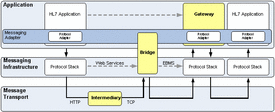Difference between revisions of "Transformer Bridge"
Rene spronk (talk | contribs) |
|||
| (3 intermediate revisions by 2 users not shown) | |||
| Line 1: | Line 1: | ||
| − | '''Transformer Bridge''' is a | + | [[Image:Ats_nonpeer.gif|275px|right|thumb|Application Architecture]] |
| + | A '''Transformer Bridge''' is a role of an [[Interface Engine]] that is allowed to change the contents of HL7 composite message without being the final destination of the HL7 interaction. A Transformer Bridge has no receiver responsibilities, is not addressed in the Transmission wrapper, and does not assign new Transmission IDs to transformed transmissions. | ||
| − | + | By definition a Transformer Bridge either has a trust-relationship with the [[Sender]] (i.e. transformations are done on behalf of, and with the knowledge of, the organization responsible for the sending application), the [[Receiver]] (i.e. transformations are done on behalf of, and with the knowledge of, the organization responsible for the receiving application), or both. These trust-relationships often (but not exclusively so) exist in intra-enterprise communication scenarios. | |
| − | + | ||
| − | + | The trust-relationship as well as the configuration parameters and communication contracts for Transformer Bridge scenarios need to be well defined and negotiated, since a Receiver needs to '''always''' be able to trust the HL7 Interaction that it receives (in terms of semantic content as well as the identification of the [[Sender]]), irrespective of whether or not is has been transformed by the Transformer Bridge. | |
| − | + | ||
| − | + | ---- | |
| + | |||
| + | Back to the [[Open ATS Issues]] | ||
| + | [[Category:ATS Glossary]] | ||
Latest revision as of 06:43, 21 March 2006
A Transformer Bridge is a role of an Interface Engine that is allowed to change the contents of HL7 composite message without being the final destination of the HL7 interaction. A Transformer Bridge has no receiver responsibilities, is not addressed in the Transmission wrapper, and does not assign new Transmission IDs to transformed transmissions.
By definition a Transformer Bridge either has a trust-relationship with the Sender (i.e. transformations are done on behalf of, and with the knowledge of, the organization responsible for the sending application), the Receiver (i.e. transformations are done on behalf of, and with the knowledge of, the organization responsible for the receiving application), or both. These trust-relationships often (but not exclusively so) exist in intra-enterprise communication scenarios.
The trust-relationship as well as the configuration parameters and communication contracts for Transformer Bridge scenarios need to be well defined and negotiated, since a Receiver needs to always be able to trust the HL7 Interaction that it receives (in terms of semantic content as well as the identification of the Sender), irrespective of whether or not is has been transformed by the Transformer Bridge.
Back to the Open ATS Issues
